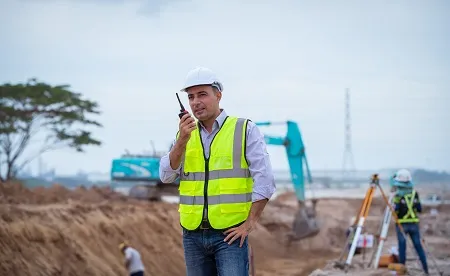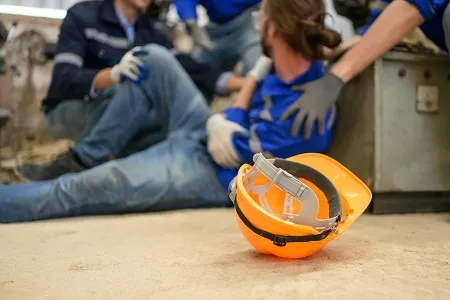Why Contractor Inductions are important
Almost every business has to engage different contractors at one point or the other. One of the primary challenges that businesses face when this happens is that it’s difficult to gauge to what extent such should be inducted. Do you put in the same effort in inducting your contractors as you do the employees although they’re going to spend only a few hours on-site? If not, how do you approach contractor induction in a way that protects you from liability?
Data from Safe Work Australia on work-related fatalities indicates that 144 Australians were fatally injured at work in 2018. There was a significant improvement as during the previous year, there were a total of 189 work-related fatalities. These figures can be further reduced through contractor inductions.
Who Is a Contractor?
A contractor is a company or an individual who agrees to provide your business with certain goods or services for a certain duration. While you may have a clear of the deliverables as stated on the contract, they cannot dictate or define the contractor’s working pattern. A contractor can choose to charge you per day, by the hour, or a lump sum. In most cases, a contractor will specify the milestones if partial payments are to be made.
Most organizations use contractors for services such as:-
- Construction work
- Catering
- Security
- Marketing
- Cleaning
- Gardening
- Recruitment
- IT infrastructure maintenance and support
A subcontractor is different from a contractor in that the former doesn’t deal with the client directly. Rather, they undertake a task that the contractor is responsible for but which they cannot do. For example, a contractor may hire a plumbing company to complete the plumbing works in a construction project.
Types of Contractors
While the term ‘independent contractor’ describes people in virtually any field, the contractor fields tend to be more specific. The different types of contractors include:-
- General contractors
A general contractor is responsible for the day-to-day operations of a construction project. He is responsible for managing any sub-contractors involved in the project as well as handling client and vendor communication when the need arises. A general contractor will also manage the project’s budget, its schedule, and payments if need be.
Hiring a general contractor makes your work easy as you only need to hire one person who oversees that everything is done at the right time. On the downside, a general contractor charges you for any extra task he does. For instance, if an electrician would charge you $1,500 for your project, a contractor might charge you $2,000 as they have to find a qualified electrician, hire them, and take responsibility for the outcome.
- Speciality contractors
These are companies or individuals who are an authority in a specific field, for example, plumbing, electricity, security, painters, heating and duct work professionals, and so on. They are usually qualified professionals who have been licensed and insured to carry out certain tasks.
Contractor Induction
Australia’s Work Health and Safety Act 2011 (WHS Act) requires that you extend workplace safety to your contractors and other third parties. Not extending this type of safety to your contractors may result in hefty fines, penalties, or even jail time. Before commencing with a project, you must ensure that they have the experience, skills, knowledge and if required, have the organisational capacity to carry out their tasks safely and without risking their health.
The 2012 Health & Safety Handbook goes on to state that “you have a duty of care for the health and safety of a contractor’s workers when they are performing work on your work-site. This is your general duty of care under health and safety legislation, meaning that it is a duty that you cannot contract out or transfer over to another party, e.g. a contractor. In principle, you, therefore, owe the same duties to contractors and their workers as you do to your own workers.”
This means that even though you have hired a contractor for their expertise in a specific field, it’s not up to them to identify site hazards or adopt a safe working environment. Rather, you have to take them through intensive safety training to ensure that they are familiar with workplace hazards, how each can be mitigated, and the relevant health and safety policies and procedures.
The contractor’s duty towards health and safety
Just like regular workers, the WHS Act requires contractors to take ‘reasonable’ care as they carry out given projects. They have a duty to:-
- Take care that their acts or omissions do not affect the health and safety of others
- Be reasonable about caring for their health and safety
- Comply with reasonable instructions and directives given by the Person Conducting a Business or Undertaking (PCBU) to comply with the WHS regulations
- Cooperate with the PCBU on any policies and procedures that relate to health and safety at the workplace
Best practices for contractor safety
Some of the practices that will help you ensure contractor safety include:-
- Pre-qualification
Before hiring a contractor, you have a responsibility to do some due diligence. This includes researching the contractor’s safety records, their work culture, and how they deal with safety-related statistics. As a rule, you should require contractors in your organisation to submit documentation and statistics before hiring, including any safety records that demonstrate their commitment to safety.
- Pre-project assessment
Your organisation should carry out risk and task assessment before the contractor commences with the project. Apart from helping you and your contractor understand the risks at the workplace, it helps the contractor have a clear picture of the scope of their work. This assessment could pave way for supplementary safety programs and training.
- Orientation and training
Use the contractor’s performance during the training to approve or give them the go-ahead to commence with work. This is also a good opportunity for you to obtain any permits, licenses, professional certifications, and any other document that’s relevant to the project. During the orientation phase, the contractors will familiarise with the site. This is your chance to show them where basic amenities such as washrooms, fire assembly points, where they can wash their hands, canteens (if any), and other site-specific amenities are located.
- Monitoring
Regardless of the length of the contract between you and your contractor, you will need to come up with milestones for periodic checks. This could include site walk-through’s, safety checklist, talks, and other safety assessments. If possible, provide your contractors with regular material and content that will help them remain vigilant as far as non-compliance, hazards, and unsafe practices are concerned.
- Post-project evaluation
This is a critical part that most organisations miss. Oftentimes, we concentrate on the process of sourcing for the right contractor that we fail to evaluate whether the task was carried out correctly and safely. You can evaluate the contractor’s performance by reviewing their injury rates, studying contractor reports, and observation. This will help you know whether the contractor training was effective and whether safety was prioritised. This will help you in future contractor screenings.

How Induct for Work can be used in Contractor Training and Induction
For most organisations, the conventional induction process is time-consuming, costly, and inconsistent. Changing your induction process can revolutionise your contractors’ health and safety practices and strategies. Apart from the mentioned challenges, other problems organisations face during contractor induction include:-
- Managing multiple sites
- Inducting and training several contractors at a go
- Evaluating the contractors’ comprehension level
Some of the ways through which Induct for Work can help your organisation overcome these challenges include:-
- Personalised induction material
It probable that you will be hiring contractors for different purposes. You should ensure that induction training is tailored to their role and expertise. For instance, you will need to upload different content for your cleaners than you would the electricians in your site. Induct for Work enables you to upload materials, tasks, and content and then assign these to specific contractors. The platform enables you to categorise your training and induction material into modules. Once the contractor has read, understood, and successfully carried out an assessment test, they can sign up for further training.
Each contractor will have their profile that has their details, skills, and the induction modules they undertake.
- It helps you prioritise your induction material
Projects that involve lots of health and safety material can make your contractors feel overwhelmed. Induct for Work enables you to plan and prioritise your induction content. For example, you may start with the basics and add specialist learning as the training progresses. After each segment, you can add a questionnaire or a test to assess how much content the contractor learnt, remembered and understood.
- Contractors can be trained and inducted remotely
As it is cloud-based, your contractors can get the necessary training even before they set foot on your site. Also, they can always refer to your content in the future if need be. Online induction also enables you to have a wider reach using the same training methodology. The content on Induct for Work is optimised for mobile access.
- It allows for better contractor management
Contractor management refers to a form of management used for projects or tasks in which some or all of the workers involved are contract workers, as opposed to a task or project in which the entire workforce works for the PCBU. Contractor management systems are mostly used in the construction industry, where multiple organisations are contracted to carry out different parts of a single project.
This is a critical part of workplace health and safety as risks tend to increase when there are more than two participants. This is as a result of the increased complexity of enforcing and administering compliance of safety standards and behaviours among workers in different groups.
Induct for Work enables you to collect contractor documents for better contractor management. These documents may include:-
- Insurance
- Field certifications
- Training evidence
- Right or permit to work in Australia
- Licenses
- Contact details in case of an emergency, and
- Payment details
The platform enables you to set automatic reminders when such documents expire. You can then prompt your contractors to renew and supply you with updated documents on an ongoing basis.
- It enables you to cover a wide range of topics simultaneously
An effective induction training should cover a wide range of topics including an introduction to the workplace or the site and safety policies and procedures, among others. Induct for Work induction templates cover topics such as:-
- Duty of care
- Contractor obligations
- How to handle hazardous chemicals
- Electrical safety
- PPE and safety
- Alcohol and drugs
- How to ensure environmental sustainability, and so on
You can tailor the content to what suits your organisation or industry.
How Induct for Work works for Managers
Step 1: Come up with a list of contract organisations that your business engages and send an email with a link to the induction material
Step 2: Train any administrators or project leaders on how to validate that the contractor has successfully gone through the training
Step 3: Set a deadline after which contractors are not allowed to get to the site without having completed the induction training and obtained a certificate
Step 4: Validating of contractor documents
How Induct for Work works for Contractors
Step 1: Receive the link to the induction content
Step 2: Register, login, and submit the required documents
Step 3: Complete the online induction and training
Step 4: If successful, print and sign the induction certificate
Induct for Work ensure that your contractors get consistent content no matter where they are. Also, the content can be translated depending on where you contractors are from. This also makes this platform suitable for organisations with multiple sites in different parts of the world.
Do you have any questions or great tips to share?
Induct for Work – the only online induction system you would need to run online inductions.



